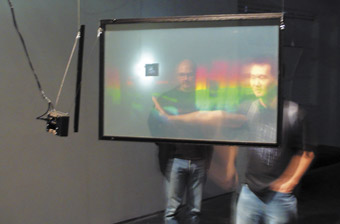the dimensions of perception
amy marjoram at beyond the window

Martina Mrongovius, The Crossing
courtesy the artist
Martina Mrongovius, The Crossing
IMAGES CAN STIMULATE BODILY AWARENESS AND EVOKE, AT LEAST MOMENTARILY, SOME OF THE COMPLEXITY OF ACTUAL EXPERIENCE. THE GROUP EXHIBITION BEYOND THE WINDOW STROVE TO MAKE THIS PHYSICAL CONNECTION MORE EXPLICIT. CURATOR MARTINA MRONGOVIUS WRITES OF ENGAGING “THE VIEWER’S EMBODIED PALETTE OF SENSE TO EXPRESS SOMETHING BEYOND THE IMAGE.” CENTRED ON PHOTOMEDIA, THIS AMBITIOUS SHOW HAD THE POTENTIAL TO CREATE A SUBTLE AND EXPANDED UNDERSTANDING OF PICTORIAL IMMERSION.
The core of the exhibition comprises a suite of holographic images by Mrongovius. With their bursts of neon greens and oranges the holograms look like defunct technology for gimmicky toys rather than invoking sophisticated industrial uses. Yet, the sense of the mysterious technical complexity of etching an image with dimensional fidelity on a durable surface is nonetheless present.
The Crossing (2007), a suspended hologram diptych of numerous overlayed architectural details, was accompanied by a responsive soundscape by Philippe Pasquier. Against the difficult-to-pin-down holographic imagery, Pasquier’s shards of urban sounds seem too dense, consistent and coherent, failing to connect with the necessarily subtle movements of eyes, head and body with which the curious viewer has to navigate The Crossing’s chimerical visuals. Mrongovius’ holography makes intrinsic demands on the viewer to sway about to gain access to the imagery. If the sound component of The Crossing had likewise articulated the limits of perceptual mediation it may have connected with the tantalising dexterity of the holography.
Mrongovius inserts three dimensionality into the picture plane, yet the illusory nature is technologically restricted allowing for only partial, momentary articulation. This strained interaction highlights gaps between normal perception and what the pictorial holograph, and by association the mechanical expansion of vision in all photomedia, can provoke. Importantly, with these works we don’t so much move ‘beyond the window’ as bob about in front of it.
This was evident in the wonderfully awkward activity required to view Mrongovius’ We’re all looking series (2007). To find the images, viewers rolled back and forth with legs akimbo, for balance, on excessively low, cheap office chairs. The sliding illuminated photographic sequences of a group performing choreographed movements, iterating the artist’s focus on the perception of bodily motion.
In one hologram the movements involved the group simultaneously bobbing down, then standing and taking a photo, as if capturing the viewer. In this witty reversal the audience, instead of being positioned as transported witnesses, became the spectacle themselves, focused on by synchronised camera-wielders.
These holographic works took up the central gallery, with adjoining galleries each housing another work. Overly defined by the structural flow of the space, this seemed a self-conscious installation strategy. Mrongovius’ work dominated and surrounding works acted as weaker satellites. This lack of fluidity in exhibition layout was exacerbated by the use of elaborate custom made lightboxes to label each work. This appeared a stultifying attempt to re-emphasise curatorial coherence.
Another three-dimensional work (Erin Veronica Ender, Rachel Hanrahan and Max Hem) comprised two vintage stereo viewers. Peering through binocular lenses and then twisting a handle caused three dimensional photographs to flip forward, the images including Ender and Hanrahan wearing faux pilot costumes with glitter leggings. The stereo viewers as artefacts were wonderful, yet the artists’ intervention failed to reinvigorate them or expand the curatorial premise—the work seemed pointlessly flippant.
A similar over reliance on technical proficiency was evident in Yandell Walton and Clare Hassett’s Emergency (2008). A large photograph of a grief stricken woman sitting in a hospital was overlayed with a projection of an ethereal male figure slowly moving about her. This opposition failed to draw inspiration from the strong artistic tradition of exploring the nexus between photography and the moving image—the relationship remained uninterrogated.
The works in Beyond the Window were like dominoes, each highlighting the problematic strategies used in the next, the exhibition toppling into a survey of coy assaults against the still image. The experiential conditions to immersively ‘stretch the notion of the image’ were not realised. While the ingrained sensorial tension between the experience of the actual and the pictorial and their overlap was successfully articulated by Mrongovius’ The Crossing (if not in the sound collaboration), as a program about perception, Beyond the Window became paradoxically a catalogue of clunky, thwarted escapes.
Beyond the Window, curator Martina Mrongovius; Bus Gallery, Melbourne, March 18-April 5
RealTime issue #85 June-July 2008 pg. 30-31






